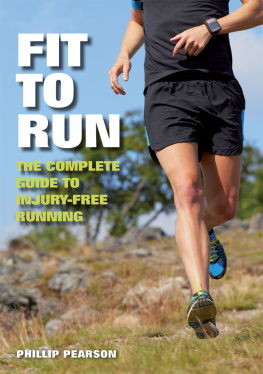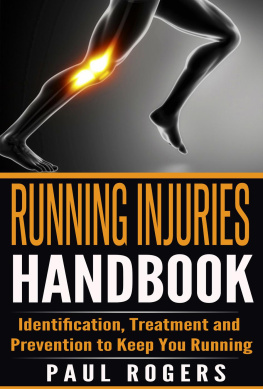Front Matter

Injury-Free
Running
Your Illustrated Guide to Biomechanics,
Gait Analysis, and Injury Prevention
Second Edition
Tom Michaud

Copyright 2021 by Tom Michaud. All rights reserved. No portion of this book, except for brief review, may be reproduced, stored in a retrieval system, or transmitted in any form or by any meanselectronic, mechanical, photocopying, recording, or otherwisewithout the written permission of the publisher. For information, contact Lotus Publishing or North Atlantic Books.
First published in 2021 by
Lotus Publishing
Apple Tree Cottage, Inlands Road, Nutbourne, Chichester, PO18 8RJ, and
North Atlantic Books
Berkeley, California
Illustrations Tom Michaud
Text Design Medlar Publishing Solutions Pvt Ltd., India
Cover Design Chris Fulcher
Printed and Bound in India by Replika Press
Injury-Free Running: Your Illustrated Guide to Biomechanics, Gait Analysis, and Injury Prevention, Second Edition is sponsored and published by the Society for the Study of Native Arts and Sciences (dba North Atlantic Books), an educational nonprofit based in Berkeley, California, that collaborates with partners to develop cross-cultural perspectives; nurture holistic views of art, science, the humanities, and healing; and seed personal and global transformation by publishing work on the relationship of body, spirit, and nature.
North Atlantic Books publications are available through most bookstores. For further information, visit our website at www.northatlanticbooks.com or call 800-733-3000.
Medical Disclaimer
The following information is intended for general information purposes only. Individuals should always consult their health care provider before administering any suggestions made in this book. Any application of the material set forth in the following pages is at the readers discretion and is his or her sole responsibility.
British Library Cataloging-in-Publication Data
A CIP record for this book is available from the British Library
ISBN 978 1 913088 16 3 (Lotus Publishing)
ISBN 978 1 62317 631 0 (North Atlantic Books)
Library of Congress Cataloging-in-Publication Data
Names: Michaud, Thomas C., author.
Title: Injury-free running : your illustrated guide to biomechanics, gait analysis, and injury prevention / Tom Michaud.
Description: Second edition. | Chichester, England : Lotus Publishing ; Berkeley, California : North Atlantic Books, 2021. | Revised edition of: Injury-free running : how to build strength, improve form, and treat/prevent injuries. Newton Biomechanics, 2014. | Includes bibliographical references and index.
Identifiers: LCCN 2020046187 (print) | LCCN 2020046188 (ebook) | ISBN 9781623176310 (trade paperback) | ISBN 9781623176327 (ebook)
Subjects: LCSH: Running--Physiological aspects. | Running injuries--Prevention.
Classification: LCC RC1220.R8 M525 2021 (print) | LCC RC1220.R8 (ebook) | DDC 617.1/027642--dc23
LC record available at https://lccn.loc.gov/2020046187
LC ebook record available at https://lccn.loc.gov/2020046188


One of the most inspiring scientists and clinicians I know is my good friend running guru Dr. Tom Michaud. He has changed my life, and I share his message in my own book Run for Your Life . The first book I read and studied as background was Dr. Michauds Human Locomotion . Evolutionary biology is the foundation of health, and if we understand it, we can better address why one gets ill or injured. We are living in a world mismatched with our genetic code when it comes to how we move, sleep, and eat. Dr. Michauds approach harks back to our eminent clinicians of the past: Treat every athlete and patient as a puzzle and figure it out. Start with the basics of movement for both running and walking.
Half a century ago, Oregon coach and Nike co-founder Bill Bowerman, in his book Jogging , talked about easy running as the best way to train the cardiac, respiratory, and circulatory systems. Bowerman also mentioned that for beginners, a walk/run style was ideal. For those who are new to the fitness routine, running is likely to be intense, so walk first; however, as you become more fit, walking will not be strenuous enough. So, in your journey to health, learning the skill of pain-free jogging will pay dividends as you become more fit and can spend more time jogging and less time walking.
The first edition of Injury-Free Running is a required text for all my run store employees at Two Rivers Treads as well as enthusiasts and clinicians of running. In this second edition, Dr. Michaud expands further on the same foundation that Bowerman established and millions of American followed. Bowermans Jogging was a best-seller and sold over a million copiesperhaps that same kind of success awaits Dr. Michaud. In any case, the message for many runners is to slow down, get back to the basics of movement in all facets of your life, and respect your anatomy and physiology.
In the course of my running journey, I have crossed paths with Dr. Michaud many times. At 53 years old, it is never too late for me to learn new things and share them with others. Although slowing now with age and new priorities, I have strung together 30 straight years of sub-three-hour marathons while working full time as a physician and on the side directing races, not to mention owning and managing a small community running retail. Facets of my run store have grown out of what I have learned from Dr. Michaud, including the assessment of foot strength and function as well as strength and movement.
Looking back at these marathons has given me a new perspective on running. In todays culture there is a trend and emphasis on hacks when pursuing the path to success. I agree that for immediate performance enhancement this might be true, but the jury is out if we are talking about long-term health and a lifetime of running. There are also lots of folks who read stuff, write stuff, and make claims as to what is true based on short-term results, but who do not actually run or treat runners, although many are former runners themselves.
The late Dr. George Sheehan often wrote: We are all an experiment of one. This is true, but I think one must understand the principles of overall health and how to treat the body to keep the experiment going. Since my foot surgeries in 2000, I have read, absorbed, and respected the writings of Dr. Michaud. Most proponents of pain is gain cannot produce this type of sustainable performance data with themselves or with any of their clients or athletes. I have not missed a Boston Marathon since 2000 (and have not had any running-related injuries since then either), and despite some years of extreme weather, my times are all consistent with gentle physiological age-related decline. I have finished well over 100 marathons and multiple ultras and havent worn my knees outa testament to the teachings of Dr. Michaud.
So, what is the secret sauce of long-term healthy running?
Since 2015 we have been training the US Air Force Basic Trainees to slow down, get stronger, and move better. Self-paced runs used to be efforts where the Airman felt compelled to stay with the lead group or pick a group running faster than they should based on the culture of military fitness, where you must push every day. Runners stretched and never learned how to move. The results of this mode of training were off-the-chart musculoskeletal injuries. So, we are reversing this now and teaching the principles of Dr. Michaud, before loading the system with speed and power. After training in this manner, I performed a VO max test on myself at age 50; the result was 65 ml/kg/min, the highest score for any age at the military facility, where they have done over 1,000 tests. When people ask me how I train, I share the principles of Dr. Michaud and thank him for giving me the courage to continue to train this way.














